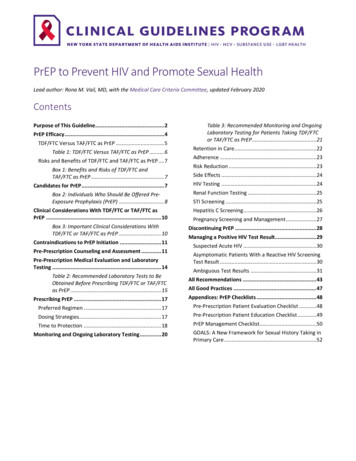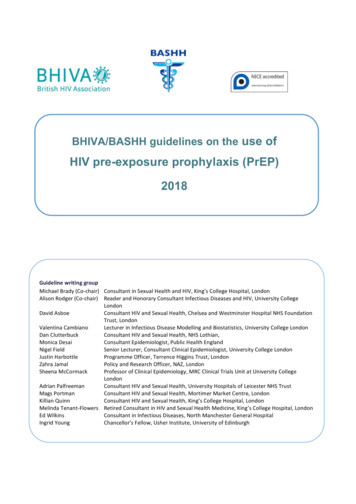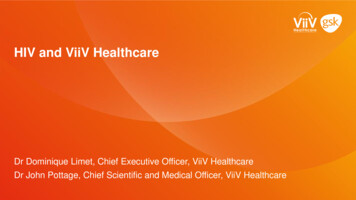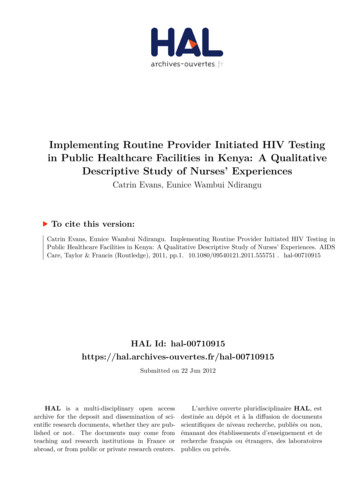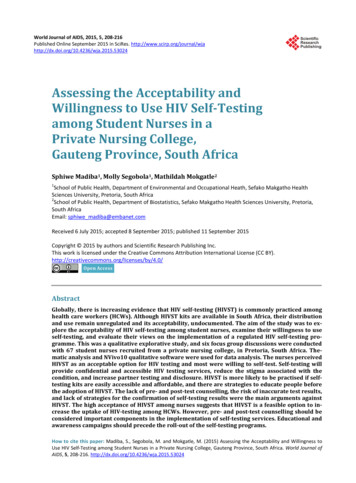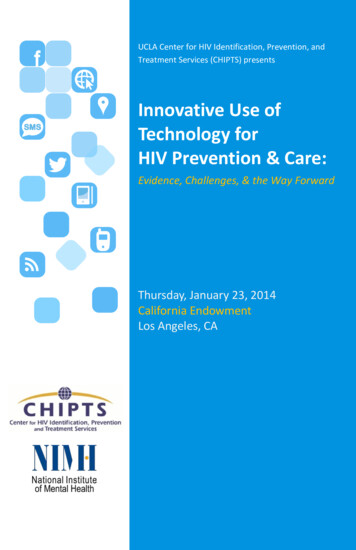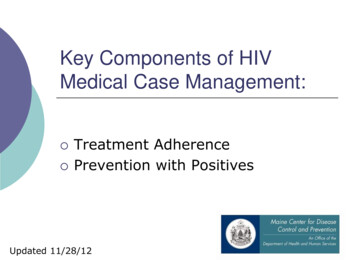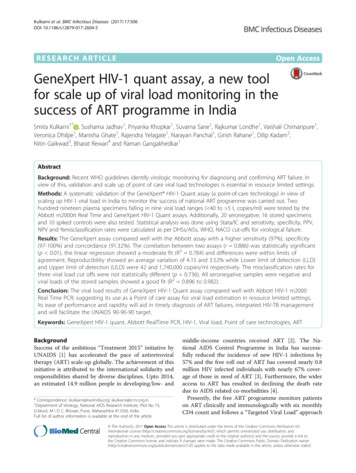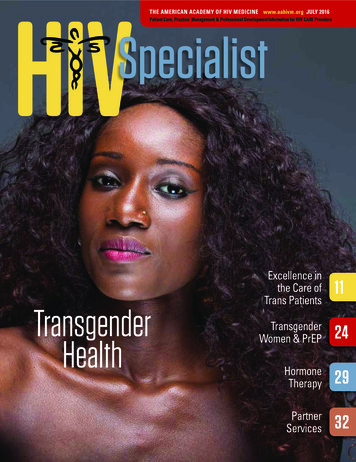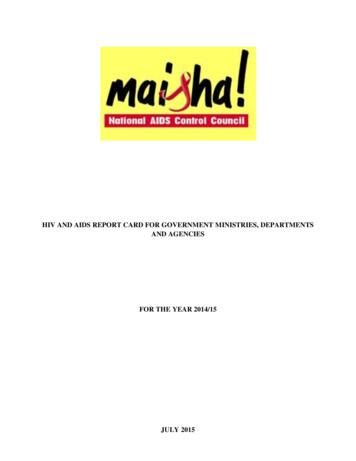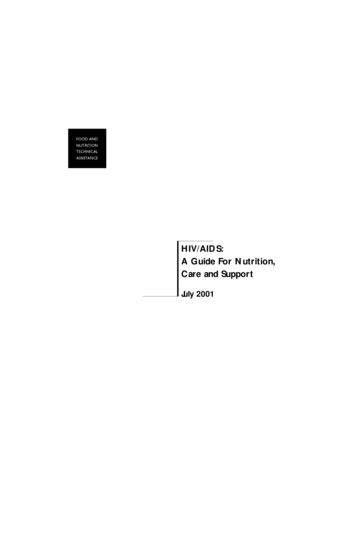
Transcription
EUROPEAN ACADEMIC RESEARCHVol. III, Issue 2/ May 2015Impact Factor: 3.4546 (UIF)DRJI Value: 5.9 (B )ISSN 2286-4822www.euacademic.orgSeroprevalence of HIV among patients attendingdental clinic in Khartoum - SudanRANIA ELGIZOULY OSMAN AHMED1M.Sc. StudentMicrobiology DepartmentFaculty of Medical Laboratory SciencesAL-Neelain University, SudanWAFA IBRAHIM ELHAGAssociate Professor of MicrobiologyFaculty of Medical Laboratory SciencesAL –Neelain University, SudanAbstract:A total of 89 dental patients who attending dental clinicsKhartoum State during April – May 2015, were enrolled in this Study,Their age range between (10-70) with mean (40).The aim of this study was to detect HIV Antibodies 0,1,2 serumspecimens were collected from dental patients and analyzed by usingEnzyme linked immune sorbent assay ( ELISA), and to detect relationbetween seropositivity and other factors including age, gender, pasthistory of dental care, and The result was showed that 1(1.1 %) werecase positive. One positive was female house wife.Key words: sero prevalence, HIV Antibodies, ELISA, dental patients,Khartoum, Sudan.IntroductionHIV is the abbreviation used for the Human ImmunodeficiencyVirus. HIV attacks the body's immune system. Normally, the1Corresponding author: raniaosman30@yahoo.com2647
Rania Elgizouly Osman Ahmed, Wafa Ibrahim Elhag- Seroprevalence of HIV amongpatients attending dental clinic in Khartoum - Sudanimmune system produces white blood cells and antibodies thatattack viruses and bacteria. The infection fighting cells arecalled T-cell lymphocytes. Months to years after a person isinfected with HIV, the virus destroys all the T-cell lymphocytes.This disables the immune system to defend the body againstdiseases and tumors. Various infections will be able to develop,these opportunistic infections take advantage of the body'sweakened immune system. These infection which normallywon't cause severe or fatal health problems will eventuallycause the death of the HIV patient 1.HIV patients are particularly affected by oral healthproblems and these have been shown to adversely impact onquality of life 2. Manifestations such as oral candidiasis, oralhairy leukoplakia, Kaposi’s sarcoma, recurrent periodontitisand gingivitis may be important markers of HIV infection 3.Access to dental care provides an important opportunityto maintain good oral health and also to identify previouslyundiagnosed infection particularly among at-risk groups. HIVposes a great challenge to health care workers, especially thosewith high probability of contact with patient’s blood or bodyfluids4,5 .This is particularly vital in the developing nations wherepre - HIV screening is not often required for routine medicalchecks, including dental examination and extraction. Althoughmedical and dental professionals are not considered high riskgroup, several hundreds are known to have acquired HIVthrough clinical accidents such as needle stick injuries 6Individuals seeking dental care may be healthy orsuffering from various infectious diseases or may be carriers ofinfectious diseases that cannot be easily identified. There isenough evidence to suggest that many infected patients areunaware of their status because of long incubation periods andpost-infection window period during which antibodies cannot bedetected 7. Moreover, such patients may act as a source forEUROPEAN ACADEMIC RESEARCH - Vol. III, Issue 2 / May 20152648
Rania Elgizouly Osman Ahmed, Wafa Ibrahim Elhag- Seroprevalence of HIV amongpatients attending dental clinic in Khartoum - Sudanspreading infection among dental health care workers andother patients in dental clinics.The aim of this study to detect sero prevelance of HIVamong patients attending dental clinics.Material and MethodsThis was descriptive –cross sectional study which had beenconducted in Khartoum state during period from April to May2015 , eighty nine dental patients were enrolled , Data wascollected by using direct interviewing questionnaire ;approvalwas taken from ethical committee of faculty of graduate studiesand ministry of health Khartoum state ,written consent alsowas obtained from dental patients who participated in thisstudy.Experimental WorkSample collection:Blood samples were collected from 89 dental patients ,underdirect medical supervision by medical vein puncture using 5ml syringe in to plain tube to obtain serum by centrifugation at5000rpm for 10min.serum was kept in -20 C till serologicalstudy was performed.Specimens were analysed by Enzyme linked immunesorbent assay (ELISA)(4th generation ELISA)(Weka -China) fordetection antigen and antibodies to Human immunodeficiencyvirus.All reagent and samples were allowed to reach roomtemperature for 15 minutes before use.Washing buffer was prepared 1:20 from bufferconcentrate with distilled water.Set the strips needed in strip-holder and numbersufficient number of wells including three Negative control,three positive controls and one Blank were set.EUROPEAN ACADEMIC RESEARCH - Vol. III, Issue 2 / May 20152649
Rania Elgizouly Osman Ahmed, Wafa Ibrahim Elhag- Seroprevalence of HIV amongpatients attending dental clinic in Khartoum - Sudan20 uL of biotinylated anti HIV,P24Ag was added in toeach well except in the blank.100uL was added from positive control and Negativecontrol and specimen according to respective wells.Plate was covered with the plate cover and wasincubated for 60 minutes at 37 C .At the end of incubation the plate cover was removedand discard.Each well was washed with wash buffer 5 times withSoaked for 30-60 seconds (washing 1).After the final washing cycle the plate was turneddown on to blotting paper and was removed any remainingliquids.100 uL from HRP-conjugates was added in to the eachwell except in the blank.The plate was covered by plate cover and incubatedfor30 minutes at37 C. After the end of incubation the platecover was discarded. Each well was washed by washbuffer(washing 2).50 uL of chromogen Aand 50 uL of chromogen Bsoluation were dispensed in to each well including the blank.The plate was covered with plate cover and mixed bytapping gently. Then it was incubated at 37 for 15 minute .lightwas avoided.The enzymatic reaction betweenchromogen A andchromogen B produced blue colour in positive control and HIV0,1/2 positive for antigen / antibodies sample wells. Plate coverwas removed and discarded from the plate, 50 uLs from stopsolution was added and was mixed gently. Intensive yellowcolor was developed in positive control of HIV 0/ 1/2 positive forantigen antibodies sample wells.EUROPEAN ACADEMIC RESEARCH - Vol. III, Issue 2 / May 20152650
Rania Elgizouly Osman Ahmed, Wafa Ibrahim Elhag- Seroprevalence of HIV amongpatients attending dental clinic in Khartoum - SudanMeasuring the absorbance:The plate reader was calibrated with blank well and theabsorbance was read at 450 nm The results were calculated byrelating each sample optical density (OD) value to Cut off valueof plate calculation of cut off (C.O) value.C.O * N c 0.12*N c the mean absorbance value for the three negative controls.The absorbance was read with micro well reader at 450 nm.Interpretation of ResultNegative result: samples giving absorbance less than cut - offValue are negative for this assay.Positive result: sample giving absorbance equal to or greaterthan cut-off considered initially reactive.Borderline: sample with absorbance to Cut off value areconsidered borderline and retesting of these sample in duplicateis recommended.Data analysis: Data was analysed by SPSS (Statisticalpackage of Social Science)software program version 16ResultsA total of 89 patients who attending dental clinics in Khartoumstate and hospital during April-May 2015, were enrolled inthis study.Their age ranges from 10-70 years, within mean 40,46(51.7%) were females, while 43(48.3%) were males.Among the total studied group 1(1.1%) showed positiveresult (fig 1), which observed among female, Most studied groupwere in age group (10-30years), 27(30.3%) (fig 2), married (68(65.2%) , and live in Khartoum, however Positive case wasobserved among Bahri patients (fig3).EUROPEAN ACADEMIC RESEARCH - Vol. III, Issue 2 / May 20152651
Rania Elgizouly Osman Ahmed, Wafa Ibrahim Elhag- Seroprevalence of HIV amongpatients attending dental clinic in Khartoum - SudanRegarding occupations most of dental patient were free acuts ,however the positive case was a house wife (fig4).None of studied group have past history ofhaemodialysis, blood transfusion or organ transplantation,however 33(37.1) had past history of surgical procedure,21(23.6%) had history of blood transfusion.Figure1: seroprevalence of HIV among dental care patients (n 89)age403020Percent10010-3031-5051-70 70ageFigure 2: Age distribution of studied dental patients (n 89)3020Residence10KhartoumCountOmdurmnBahri0Out of khartoum ve-veResultFigure 3: distribution of seropositivity of HIV among dental patients(n 89) according to their residenceEUROPEAN ACADEMIC RESEARCH - Vol. III, Issue 2 / May 20152652
Rania Elgizouly Osman Ahmed, Wafa Ibrahim Elhag- Seroprevalence of HIV amongpatients attending dental clinic in Khartoum - Sudan302010CountResult ve0-veFree actsTea makerHouse wifeEmployeeStudentHealth care workerWorkerNon workingOccupationFigure 4: distribution of HIV seropositivity among dental patients(n 89) according to occupation6050403020History o f surgicalCount10Yes0No ve-veR esultFigure 5: distribution of HIV seropositivity among dental patients(n 89) according to surgical operationDiscussionHIV infected patients should be expected in the Sudanesedental health care services with an increasing frequency.Dental care utilization in the context of the HIV epidemic isgenerally poorly understood.This study is the first one to confirm disparities indental care utilization of Sudanese adult dental patientsaccording to selected predisposing-, enabling- and need relatedfactors.The present study revealed (1.1%) seropositivity of HIVamong dental patients was a lower than the study conducted byELwalid et al (2013) in which 1.6% of HIV seropositivity wasreported among dental patients in Sudan 8. However it wasEUROPEAN ACADEMIC RESEARCH - Vol. III, Issue 2 / May 20152653
Rania Elgizouly Osman Ahmed, Wafa Ibrahim Elhag- Seroprevalence of HIV amongpatients attending dental clinic in Khartoum - Sudanlower than the result obtain by federal dental clinics, Enugu,Nigeria in which 4% were positive for HIV, also 2.3% ofprevalence recorded among oral surgery patients at theUniversity Collage Hospital, Ibadan, Nigeria 9.(1.1%) seropositivity of HIV among dental patientswhich was typical to 1.1 % reported among maxillofacailal andoral surgery patients at Medunsa10.19% of HIV was detected among tuberculosis patients injuba, southern sudan et al (2005) 11.ConclusionThe level of knowledge of HIV transmission and preventionamong dental patients in our study was low but misconceptionsthat need clarification and further education still exist.Being knowledgeable about modes of HIV transmissionand having positive attitudes towards HIV infected peopleimpacted negatively and positively on dental care utilization.Screening of dental care patients for HIV before startingtheir treatment is mandatory.ACKNOWLEDEMENTSMy acknowledgement goes to Faculty of Medical Laboratory Sciences,AL Neelain university, National public health laboratory, Khartoumteeching hospital , Faculty of Dentistry AL Neelain university, also Iam very grateful to the patients who participated in this study.REFERENCES1. Rombauts B. "Farmaceutische Microbiologie (met eneesmiddelen)." Cursus 1ste graad apotheker VUB 1997;11:14-16.EUROPEAN ACADEMIC RESEARCH - Vol. III, Issue 2 / May 20152654
Rania Elgizouly Osman Ahmed, Wafa Ibrahim Elhag- Seroprevalence of HIV amongpatients attending dental clinic in Khartoum - Sudan2. Yengopal V, Naidoo S. Do oral lesions associated with HIVaffect quality of life? Oral Surg Oral Med Oral Pathol OralRadiol Endod 2008; 106:66–733. Reznik D. Oral manifestations of HIV disease. Top HIV Med2005;13:143–8.4. Jawetz, melnick & Adelberg’s Medical Microbiology. 24th ed.McGraw Hill Companies Inc. New York, Brooks, G.F., Carroll,K.C., Butel, J.S and Morse, S.A (2007 pp. 604- 618.5. Lusby G.1 , Infection control precautions and HIV infections.In: AIDS- Concepts in Nursing practice. Ed .Gee and Moran.Wilikins, Baltimore, (1998) pp .259-279.6. Talaro, K.P and Talaro, Foundation in Microbiology. 4th ed.McGraw Hill Companies Inc. Boston, A (2002) pp. 767-776.7. Samaranayake L. Rules of infection control. Int DentJ.1993;43:578–84.8. Elwalid F, Mihaelac and Ann N, HIV /AIDS – relatedattiudes and oral impacts on dily performances: across-sectionalstudy of sudanes a dult dental patients. BMC Health ServicesResearch, 2013 ; 13-335.9. Arotiba, J.T., Odaibo, G.N., Fasola, A.O., Obiechina, A.E.,Ajagbe, H.A and Olaleye. HIV infection among oral surgerypatients at the university college Hospital Ibadan, Nigeria. Afr.J Med Sci, O.D (2003) ; 32(3):253-255.10. Dreyer, A.F., Aspinall, S., Jacobs, F.J Prevalence of markersfor HIV, hepatitis B and hepatitis C viruses in Maxillofacialand oral surgery patients at Medunsa. J Dent Assoc SAfr.(1993). 48(7):377-380.11. Michael C, Ismail O and Ahmed EL,HIV-1 infection inJuba, Southern Sudan, 2005;10.1002.EUROPEAN ACADEMIC RESEARCH - Vol. III, Issue 2 / May 20152655
dental care utilization of Sudanese adult dental patients according to selected predisposing-, enabling- and need related factors. The present study revealed (1.1%) seropositivity of HIV among dental patients was a lower than the study conducted by ELw
